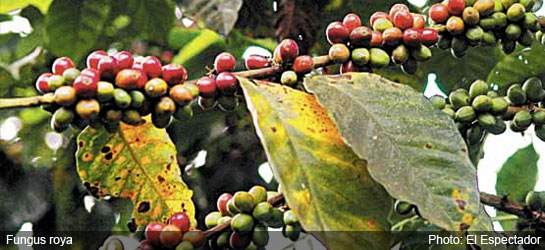
A fungus devastating Central America’s coffee crop should have a positive effect on beleaguered Colombian coffee prices by the end of 2013, according to the International Coffee Organization (ICO).
The leaf rust fungus has afflicted around 53% of the crop in Central America, the worst outbreak in 35 years, harking back to the 2010 situation in Colombia when the country’s coffee industry suffered a similar crisis.
In 2013 the number of infected Colombian bushes is below 5%, said Mauricio Galindo ICO head of operations. This is due to a combination of renewed efforts at a national level, a massive replanting project replacing the bushes with rust-resistant hybrids, and a change in climate. “It has stopped raining and returned to the traditional climate patterns,” Galindo told Colombia Reports.
The devastation in Central America will not however, have an immediate effect on Colombia’s coffee prices, which hit a three-year low in March, said the ICO official.
This is mainly due to Brazilian farmers stockpiling coffee from last year’s crop in the hopes of holding out for better prices. “Brazil has basically scored an own goal by not selling,” said Galindo. “In fact it has made the opposite happen, prices are staying low because people know that in the medium term Brazil will be able to supply the market.”
MORE: No boost for Colombia despite Central America’s coffee woes
However the situation is expected to change towards the end of 2013. “We should see a bullish pressure on prices by then as Brazil will have moved its crop,” said Galindo.
Overall the reduction of produce from Central America, which some reports are putting at around 50%, will not have an overly significant effect on world coffee production, as it does not count for a huge proportion of the whole. However, the full extent of the damage has not yet been assessed.
The ICO had predicted world production for 2013 would be around 144.4 million bags, the highest since 2000, but the organization is now working to reassess their forecasts. According to their data, over 2.5 million bags have already been lost to the crisis, and this number is rising.
The leaf rust fungus hit Colombia hard around 2007 when a fertilizer price hike caused farmers to cut down how much they used. “They didn’t apply enough fertilizer, and when they did, it was raining so much the soil couldn’t soak it up and it was washed away,” said Galindo. By 2010 over 50% of the bushes had been infected with the fungus.
The rust causes the bush to lose its leaves, and since the berries for next season grow on this season’s shoots, this season’s rust reduces next season’s crop. The infection weakens the bush and can even kill it.
Recently Central America has been suffering very heavy rain and different climate patterns along with less sunlight, perfect conditions for the advance of the fungus whose spores spread by wind and rain.
Galindo said the implications are huge for the region, with national emergencies already declared in Honduras, Guatemala and Costa Rica. By its nature coffee is labor intensive and nearly 440,000 Central American workers are expected to lose their jobs for the 2012/ 13 crop, with even more losses expected in the second half of the year.
Colombia continues to make great efforts to combat leaf rust. Cenicafe, the National Center for Coffee Investigation, is continuing research into developing resistant strains of bushes through crossbreeding. Improved weather monitoring to prevent outbreaks and research on the genetics of the rust fungus are all contributing to a massive reduction in cases – down from 50% in 2010 to less than 5% in 2013.
Currently 54% of Colombian bushes are of the hybrid, rust-resistant variety. The overall transition from the traditional bushes was fairly smooth according to Galindo, with very little resistance from unions and farmers at a national level.
The Central American farmers, on the other hand, are putting up a lot of resistance to replanting with the hybrid variety, as they believe it changes the cup quality, having been crossbred. There is also a three-year wait before a bush can produce berries.
As Colombia’s production is expected to increase by about 30% this year, according to Bloomberg, it seems as though finally things are looking up for the country’s beleaguered farmers who will be able to take advantage of reduced supplies – once Brazil’s coffee stockpiles are somewhat depleted.
Sources
- Interview with Mauricio Galindo, Head of Operations, International Coffee Organization
- ICO daily indicator prices (ICO)
- Monthly coffee market report (ICO)
- Cenicafe
- Starbucks favored coffee premium declines to lowest since 2009 (Bloomberg)
- Mexico coffee crop fungus (The Guardian)
- ICC leaf rust resolution (ICC)
- Brazil bumper crop to adversly affect coffee prices in 2013 (Commodity Online)
- Coffee rust regains foothold (Nature.com)

